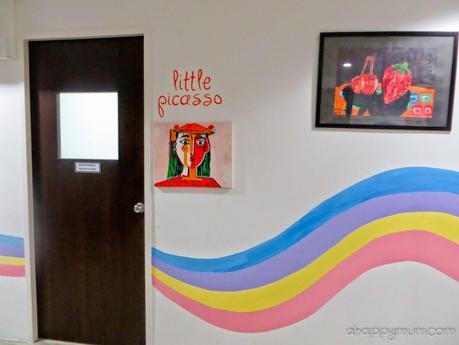 Even though the Little Picasso class is targeted at children aged 5.5 to 7 years old, the teachers at heART Studio have felt that Angel is now equipped with the necessary skills and ready to move up here from the Little Dali class. She was a little reluctant at first because she has grown to love the teachers, but that's just part and parcel of life and I am glad she eventually decided to embrace the change. In fact, she is currently loving every bit of her new class and today, we are showcasing what she has learnt in her first art project in Little Picasso.
Even though the Little Picasso class is targeted at children aged 5.5 to 7 years old, the teachers at heART Studio have felt that Angel is now equipped with the necessary skills and ready to move up here from the Little Dali class. She was a little reluctant at first because she has grown to love the teachers, but that's just part and parcel of life and I am glad she eventually decided to embrace the change. In fact, she is currently loving every bit of her new class and today, we are showcasing what she has learnt in her first art project in Little Picasso.Think of a small, vibrant and toxic animal and I think you might just get it. Yes, she is learning to sketch and paint the Poisonous Dart Frog!
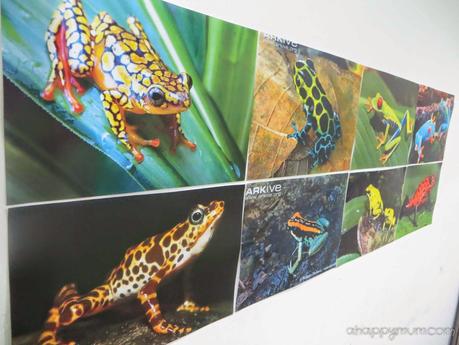
When I first found out about this theme, I was highly excited because it seemed fascinating yet a little skeptical because of the intricate details involved. I mean, come on, at age 31, I still can't draw a frog properly! So, I was really curious to see how Teacher Elma will break down the lessons and teach the children from scratch.
In Little Picasso, every theme will consist of five lessons - which means you will only get to see the final artwork at the end of five weeks. This might sound a little lengthy especially if you compare to the 3-4 weeks span for the Little Dali class. However, like I said before, I have come to appreciate the fact that heART Studio takes the time and patience to slowly train up the skills of the students and encourages them to carry out their work independently. After all, a masterpiece of art cannot be created in a day, can it?

Week 1
In the first week of class, the students were introduced to the poisonous dart frog and its characteristics. Various pictures and photographs were shown and the students even got to watch a couple of videos on YouTube so that they would be more familiar with the animal. Angel was amazed by the toxicity of the poisonous dart frog and it was heartening to see that she was picking up general knowledge along with her paintbrush.
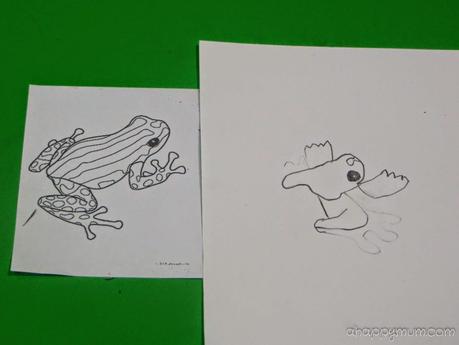 Next, the students were tasked to perform an observation drawing whereby they were told to sketch the frog based on the above picture shown. With absolutely no guidance from the teacher. Teacher Elma says this is a practice to help her gauge the standard of each student and see things from their perspectives so that she can better guide them as the class progresses. I thought this was really a smart move and it was interesting to see how each student came up with a different unique drawing. Check out Angel's distorted and weird-looking frog!
Next, the students were tasked to perform an observation drawing whereby they were told to sketch the frog based on the above picture shown. With absolutely no guidance from the teacher. Teacher Elma says this is a practice to help her gauge the standard of each student and see things from their perspectives so that she can better guide them as the class progresses. I thought this was really a smart move and it was interesting to see how each student came up with a different unique drawing. Check out Angel's distorted and weird-looking frog! 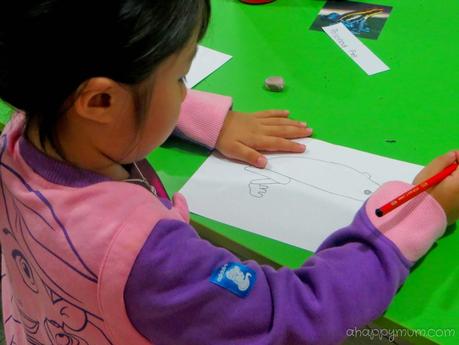 After that, Teacher Elma broke the animal down into parts and would draw them one by one on the whiteboard, starting from the body to head and legs. The students would then attempt to follow her with every step and where needed, she would step in to correct and guide them.
After that, Teacher Elma broke the animal down into parts and would draw them one by one on the whiteboard, starting from the body to head and legs. The students would then attempt to follow her with every step and where needed, she would step in to correct and guide them.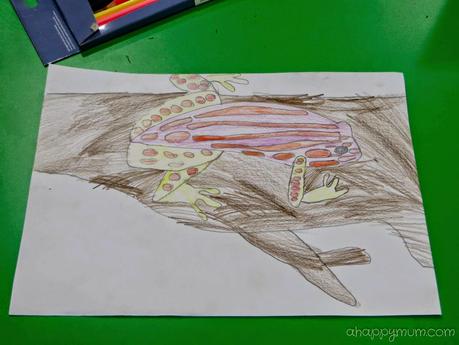 There, this was Angel's drawing at the end of the first week. I must say she was off to a great start!
There, this was Angel's drawing at the end of the first week. I must say she was off to a great start!Week 2
In the second class, the students were asked to do another drawing of the frog and this time round, instead of color pencils, they had to use soft pastels to add in the colours. It's true that practice makes perfect and you can't expect a child to remember how to draw such a complicated animal after just a couple of tries. In fact, I think she needs to keep drawing it again and again at home if she really wishes to get the shape and body parts right.
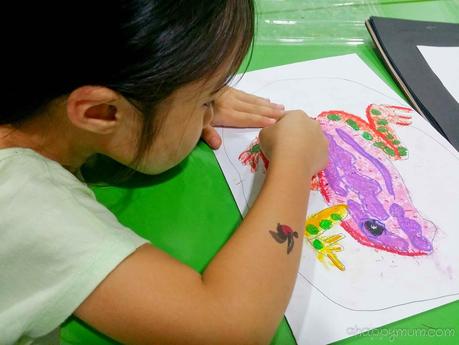 Teacher Elma taught the students two methods of using the soft pastels - the first is the standing method where you hold the soft pastel normally and the second is the resting method where you lay the soft pastel horizontally on the paper instead. This helped to create different textures and details were also added to the frogs - I was personally amazed by how much difference a small detail could make!
Teacher Elma taught the students two methods of using the soft pastels - the first is the standing method where you hold the soft pastel normally and the second is the resting method where you lay the soft pastel horizontally on the paper instead. This helped to create different textures and details were also added to the frogs - I was personally amazed by how much difference a small detail could make!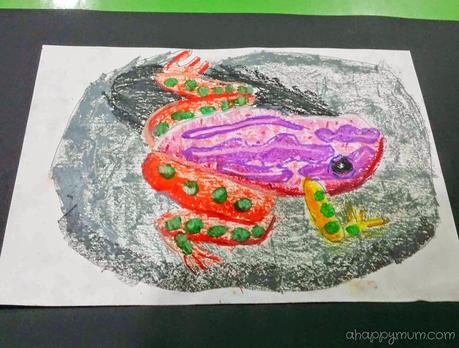 This was what Angel did in her second week, a marked improvement from the first one, don't you think so?
This was what Angel did in her second week, a marked improvement from the first one, don't you think so?Week 3
After the learning and preparation in the first two weeks, it was time to start on the final artwork and that means painting, much to Angel's delight! Since the frogs were going to have brightly coloured hues, the students had to pick either black or brown for their background and my girl decided on the latter.
 After drying the background, it was time to draw their desired foreground and start outlining using a soft pastel. Teacher Elma had printed out a variety of poses for the frogs and the students were free to choose whichever they liked. They could also decide on their own placement of the frogs, rocks, leaves, branches and plants.
After drying the background, it was time to draw their desired foreground and start outlining using a soft pastel. Teacher Elma had printed out a variety of poses for the frogs and the students were free to choose whichever they liked. They could also decide on their own placement of the frogs, rocks, leaves, branches and plants.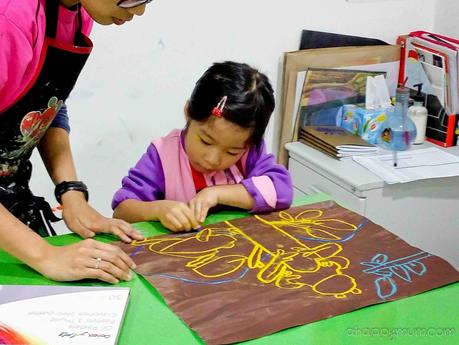
Of course, it was not easy to draw the outline of such a huge piece of work and things might not be as straightforward as they seemed. Many a time, Angel would make a mistake or draw out of shape and that was when she had to erase and redo and erase and redo. I could see that she would get pretty frustrated at times and had to learn to persevere and get over the hurdle. That is one of the main objectives of why I like to let her learn art - to realize that you should not give up easily and to understand that there is no right or wrong.
What I do like about heART Studio is that there is minimal holding of the child's hand and maximum opportunity for him/her to learn from mistakes. Even when Angel drew something that looked odd, Teacher Elma might help her to erase but she would not redo it for her and she would try her best not to hold her hand. Instead, she would patiently use her finger to draw an imaginary line from Point A to Point B and ask Angel to follow that imaginary line. This, of course, takes times and that is why we do need five weeks to accomplish a great piece of art.
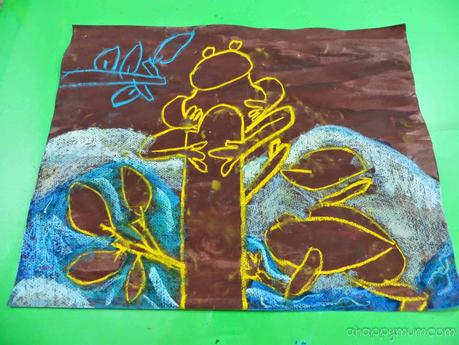 See? This was what she achieved by the end of the third lesson. A frog hugging a bamboo plant, how cute!
See? This was what she achieved by the end of the third lesson. A frog hugging a bamboo plant, how cute!Week 4 & 5
In the last two weeks of class, the students were to add in the colours and details according to what they had learnt previously. They were given the autonomy to select each of the colours and pattern that they wanted for the skin of the frog.

In order to make it look more realistic, they also made use of both the standing and resting methods and added in highlights, textures, layers and details using the soft pastels.
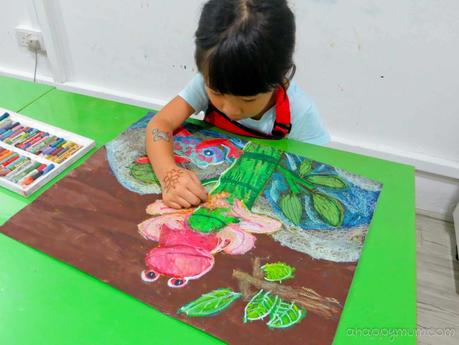 With each lesson lasting 1hr 15min, the students were given ample time to finish every task and there was no rushing through at all. They would also usually go for a toilet break and at the end of the class, they would clean not just their own hands, but also their buckets, brushes as well as keep all the soft pastels. I think that is definitely a good way to train them up to have a sense of independence and responsibility.
With each lesson lasting 1hr 15min, the students were given ample time to finish every task and there was no rushing through at all. They would also usually go for a toilet break and at the end of the class, they would clean not just their own hands, but also their buckets, brushes as well as keep all the soft pastels. I think that is definitely a good way to train them up to have a sense of independence and responsibility.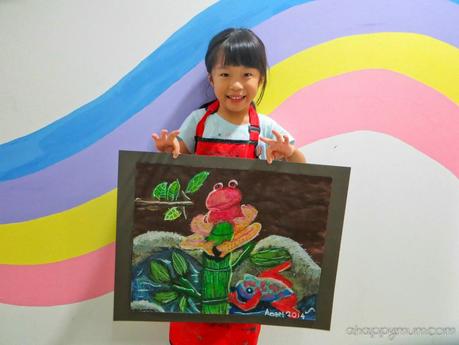 TA-DAH! Presenting Angel's final poisonous dart frog artwork! How do you think she fared?
TA-DAH! Presenting Angel's final poisonous dart frog artwork! How do you think she fared?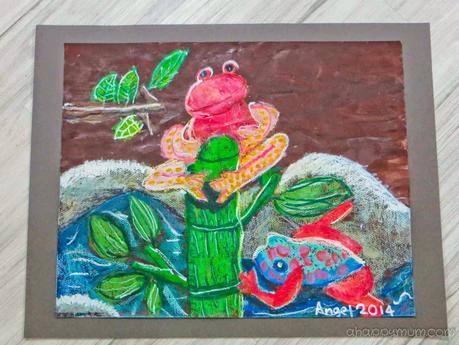 I don't think I am biased but she did quite a good job, didn't she? In fact, I took a look at the works of the other students and I must say everyone did amazingly well.
I don't think I am biased but she did quite a good job, didn't she? In fact, I took a look at the works of the other students and I must say everyone did amazingly well.For this to be the first artwork she produces at Little Picasso, I think it is the start of many more wonderful things to come in her art journey.
******
heART Studio believes in providing quality Arts education for all their students to gain mastery in making art, to nurture their creative potential and to cultivate a community of artists and art lovers of all ages. Its class programmes include age appropriate activities uniquely designed to engage and inspire young artists, aged 3-12, to cultivate their creativity and learn technical art skills. For more information, visit www.heartstudiosg.com.
Disclosure: This is part of a series of reviews between heART Studio and A Happy Mum. Angel attended a term of sponsored art lessons for the purpose of writing this review. All opinions are our own.

